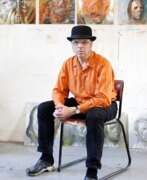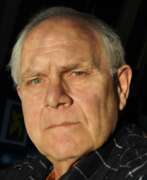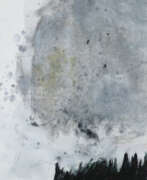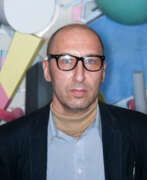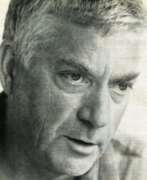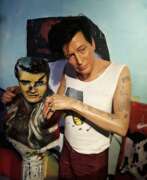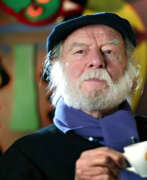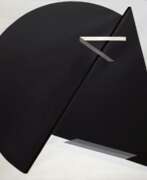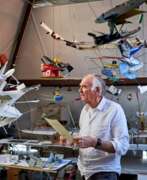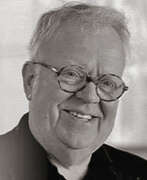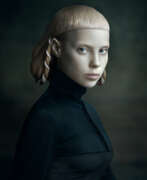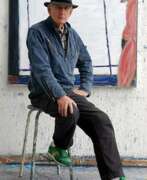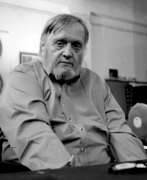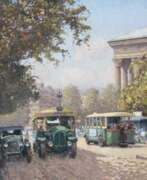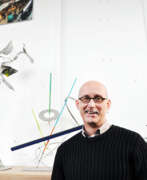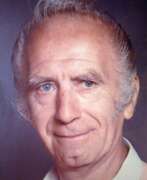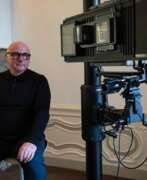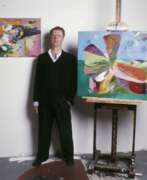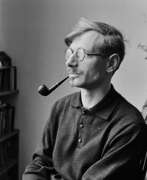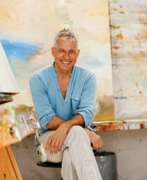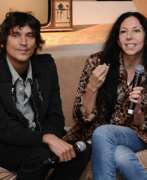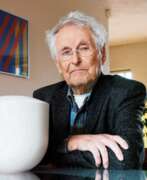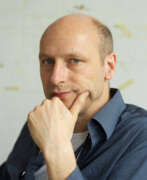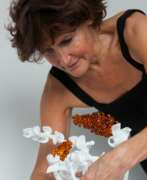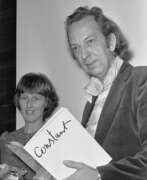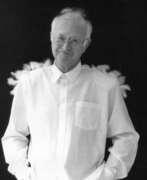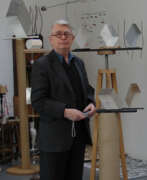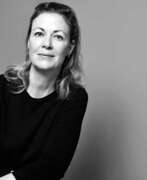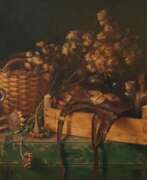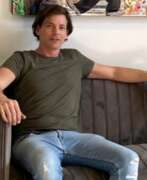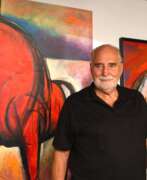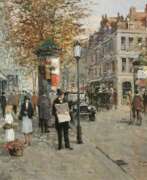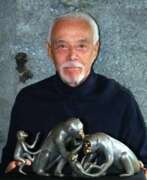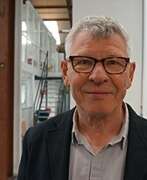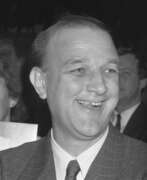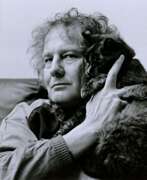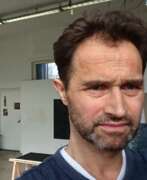The Netherlands 21st century
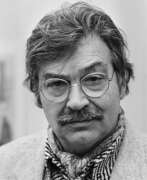

Christiaan Karel Appel was a Dutch painter, sculptor, and poet. He started painting at the age of fourteen and studied at the Rijksakademie in Amsterdam in the 1940s. He was one of the founders of the avant-garde movement CoBrA in 1948. He was also an avid sculptor and has had works featured in MoMA and other museums worldwide.
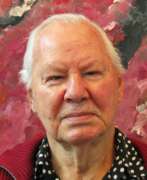

Armando, born Herman Dirk van Dodeweerd, was a Dutch painter, sculptor, poet, writer, violinist, actor, journalist, film, television and theater maker. Armando was his official name; his birth name, the pseudonym as he called it, no longer existed for him. He himself saw his work as «Gesamtkunstwerk», based on his experiences from the Second World War in the vicinity of Kamp Amersfoort.


Rob Birza is a Dutch painter and sculptor living and working in Amsterdam.
Rob Birza studied at the Academy of Visual Arts Sint-Jost in Breda and at Atelier '63 in Haarlem. He initially painted paintings, gouaches, and watercolors and quickly gained recognition in the Dutch art scene. The artist combined medieval painting techniques with contemporary subjects borrowed from comic books and television series. In his work, he regularly referenced the works of modern masters, contrasting banality and high art. Figural canvases and abstract compositions alternate with colorful still lifes with flowers and large-format paintings depicting scenes of the Afghan war.
Since the 1990s, Rob Birza has also begun to create installations with figures made of styrofoam, papier-mâché and other materials. These figures often contrasted sharply with the paintings. Birza also combined furniture like chairs and lamps in his works.
Rob Birza's work has been widely exhibited in numerous solo and group exhibitions both nationally and internationally and is included in many private and public collections.
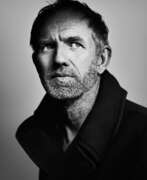

Anton Corbijn is a renowned Dutch photographer, film director, and music video director, born on May 20, 1955, in Strijen, the Netherlands. His career took off photographing musicians like Herman Brood, eventually leading to international acclaim. Known for his long-standing collaborations with bands Depeche Mode and U2, Corbijn has creatively directed their visual outputs for over three decades.
Corbijn's artistic prowess extends to directing critically acclaimed films such as "Control" about Joy Division's Ian Curtis, which garnered multiple awards, including the Michael Powell award for best new British feature at the Edinburgh International Film Festival. His other directorial works include "The American" and "A Most Wanted Man". In photography, his portraits span icons like Jimmy Page, Robert Plant, and Bob Dylan, with his pieces often gracing album covers for many influential music acts.
Collectors and experts recognize Corbijn for his distinctive style that captures the essence of his subjects, making his work highly sought after in the art and music worlds. His notable works are displayed in museums and form an integral part of music history, as seen in his album covers for Metallica, Nick Cave, and others.


Jaqueline de Jong is a Dutch painter, sculptor and graphic artist living and working in Amsterdam and Bourbon, France.
In her painting practice, she easily switched between different styles, from expressionist painting to new figuration and pop art, repeating motifs of eroticism, desire, violence and humor. From prints to large oil paintings, she displays a fascination with the grotesque and the macabre, especially in the more figurative works depicting creatures that are half human, half beast. It is as if they reveal the ugly or animal side of human nature that we usually prefer to hide.


Rineke Dijkstra is a Dutch photographer. She lives and works in Amsterdam. Dijkstra has been awarded an Honorary Fellowship of the Royal Photographic Society, the 1999 Citibank Private Bank Photography Prize (now Deutsche Börse Photography Prize) and the 2017 Hasselblad Award.
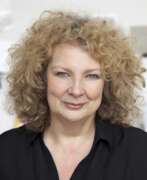

Marlene Dumas is a Dutch artist of South African origin. She is known for her figurative paintings that explore themes of identity, race, gender, and sexuality.
Dumas studied at the University of Cape Town and later moved to the Netherlands, where she earned a degree from the Ateliers '63 in Haarlem. Her early work was heavily influenced by the political and social climate in South Africa during the apartheid era.
Dumas' paintings often depict people in various states of vulnerability, intimacy, and emotion. Her works are characterized by loose, gestural brushstrokes, and a limited color palette. She frequently draws inspiration from popular culture, news media, and art history, often appropriating and reimagining images from these sources.
Dumas has exhibited her work extensively, including at the Museum of Modern Art in New York, the Stedelijk Museum in Amsterdam, and the Tate Modern in London. She has also received numerous awards and honors for her work, including the Johannes Vermeer Award in 2012 and the Premium Imperiale in 2018.


Benedikt Hipp is a German painter and sculptor who lives and works in Munich and Amsterdam.
Hipp studied at the academies of fine arts in Nuremberg, Munich and Bologna. Even during his studies he attracted attention with his characteristic works. His paintings and panels, some of them large format, are created in the technique of the old masters - oil paints on wooden panels and varnished.
For example, one of Hipp's latest works, the series "Ocean Bark" embodies an artistic confrontation with the last unexplored corner of our earth - the depths of the sea. These works are created as a result of a rather complex technological process and create a fantastic impression reminiscent of surrealism. Architecture, animals and people are alienated, united and presented in a disturbing, dreamlike way.
Benedikt Hipp is an extremely versatile artist who expresses himself in several genres. He has works on paper, collages and ink drawings, recently focusing on objects and sculpture as well as spatial installations.
In 2021, Hipp was awarded the Rome Prize Fellowship of the Deutsche Akademie Villa Massimo, Germany's most renowned award for artists.
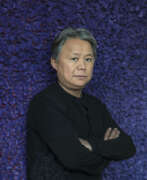

Zhuang Hong Yi is one of China's most famous artists.
He currently lives and works in a studio in China and a residence in Switzerland. Zhuang received his first education at the Sichuan College of Fine Arts in China and moved to the Netherlands in 1992, where he continued his studies at the Minerva Academy in Groningen.
He received a powerful boost of inspiration when he saw the famous tulip fields among the picturesque Dutch landscapes. The powerful blossom of nature has been the main subject of Zhuang Hong Yi's creations ever since. His works are characterized by bold color schemes and intricate, repetitive floral motifs.
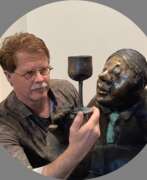

Sjer Jacobs is a Dutch painter and sculptor.
Jacobs creates sculptures in ceramics, bronze, iron, Corten steel, copper, glass and stone, paintings on canvas and stainless steel plates, wire figures, steel and iron panels and screen prints.... All his works are about people in ordinary life: his men and women, like everyone else, waiting in the reception area of an office building, sitting on a park bench or walking down a shopping street, meeting for drinks, music and conversation. These people are close to everyone.
Sjer Jacobs' larger ceramic and bronze works are always one-of-a-kind, while smaller ones are often produced in editions, but even so, each sculpture is unique.


Juul Kraijer is a Dutch visual artist. Her work has been exhibited internationally, and is included in major museum collections such as the Museum of Modern Art, New York City, the Museum of Old and New Art, Tasmania and the Kupferstichkabinett Berlin.
Her principal mediums are drawing, photography and collage. She occasionally makes sculptures and video-works.
Kraijer's works share an emblemata-like concision, showing no more than what is strictly necessary. In each image, the figure looms out of an undefined background. Definition of time is absent as well. No hairstyles or dress belonging to any specific period are shown, no hint of a narrative is present. The postures and facial expressions are deliberately restrained and intensely concentrated. They seem to have been adopted for eternity. Faces and bodies are a vehicle for meaning rather than portrayals of individuals. The impassive visage, in a state of half-sleep, seems to exist at an interface between self-awareness and self-extinction. The images elude traditional iconography. Kraijer creates naturalistic images that are memorably strange.


Joris Hendricus Laarman is a contemporary Dutch designer, artist and entrepreneur known for his interdisciplinary approach that combines art, design and technology. He is internationally recognised for his pioneering creations in various fields, including furniture design, architecture and experimental production methods.
Joris Laarman studied at the Eindhoven Academy of Design. During his studies, he co-founded an experimental design collective called Lab, which aimed to challenge traditional design methodologies and explore the possibilities offered by digital production technologies.


Willem Lenssinck, a Dutch-German sculptor and designer born in 1947, has carved a unique niche in the world of art and design. Growing up in Utrecht, the Netherlands, he developed a keen interest in the arts, later attending the Academy of Fine Arts (HKU). After graduating in 1969, he was immediately hired as a designer for industrial ceramics at Royal Delft, marking the beginning of his illustrious career.
Lenssinck's work is a fascinating blend of sculpture and design, characterized by futuristic aesthetics, sharp lines, and highly polished surfaces. His favorite subjects, such as horses, machines, and female figures, often convey a sense of technological advancement and transformation. He has been particularly noted for his sculptures in bronze, German silver, stainless steel, and aluminum, as well as his innovative furniture and lighting designs.
A pioneer in utilizing 3D design techniques, Lenssinck has embraced new technologies to push the boundaries of traditional sculpting. Since 2005, he has been using these processes to overcome limitations in traditional modeling, allowing for more complex and precise creations. This approach is evident in his sculptures, which often feature intricate interplay between organic and mechanical forms.
Lenssinck's work is globally recognized and can be found in prestigious collections, including the British Museum in London and the Museum Beelden aan Zee in Scheveningen. His contributions to art have been acknowledged with several accolades, including the Pieter d’Hont Award in 1991. His presence at prominent art fairs like the PAN Fine Art Fair in Amsterdam and TEFAF in Maastricht has further cemented his status as a distinguished artist.
For collectors and aficionados of contemporary art and design, Willem Lenssinck offers a unique exploration into the fusion of art and technology. Sign up for updates and immerse yourself in the world of a sculptor who defies the conventional, blending creativity with cutting-edge techniques. Stay informed about exhibitions, sales, and events featuring the intriguing works of Willem Lenssinck.


Stijn Peeter is a contemporary niderlandian artist. He studied first at the Royal Academy of Art and Design at 's-Hertogenbosch and then at the Jan van Eyck Academy in Maastricht. He taught at several Dutch art academies and is currently with the Fontys School of Fine and Performing Arts in Tilburg. Stijn Peeters makes many small works (drawings, graphics) on paper. His paintings however are often (very) large. His work is on display regularly in museums, art galleries and other art venues in the Netherlands and abroad. He is no stranger to self-irony in work like his "Into the doghouse" drawings, in which he visualizes his own life as that of a dog. Another recurrent theme in Stijn Peeters' work is 'The world upside down'. Mythological stories and images on folkloristic prints are other sources of inspiration.


Peter Royen is a Dutch and German painter, graphic artist and sculptor, member of the Malkasten Association of Artists.
Peter Royen is widely known for his white silent paintings, for which he has been called the "artist of silence". Royen endlessly experimented with his beloved white, layering and layering it in different variations, combining it with other colors. Right angles, squares, rectangles, stripes feel comfortable in white, sometimes they are lost in it or even dissolve.


Peter Schuyff is an internationally exhibited Dutch-born American painter, musician and sculptor. In 1967 moved with his family to Vancouver, Canada. Schuyff's mother was an artist and his father a professor of economics at Simon Fraser University. Peter became fascinated with the radical views of the art world in the 60s and 70s and especially with such famous figures as Andy Warhol and Willem de Kooning. He was raised in Canada and was schooled in art at the Vancouver School of Art.


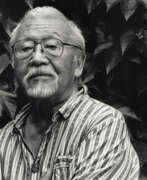

Shinkichi Tajiri is an American and Dutch painter and sculptor.
He was the child of first-generation immigrants from Japan to the United States. He moved to Paris in 1949 and studied with Osip Zadkin and Fernand Léger, and moved to the Netherlands with his Dutch wife in the late 1950s.
In addition to sculpture, Tajiri was active in painting, photography and filmmaking. The central themes of his work - speed, eroticism, force or violence — represent a constant confrontation with the madness of World War II and its aftermath. The recurring images of the knot and the warrior and the themes of war and violence became Tajiri's way of crystallizing the horrors he had personally experienced. Documenting the Berlin Wall would later become a central project for him.
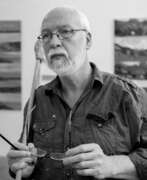

Jaap van den Ende is a Dutch artist and painting teacher.
Ende studied at the Royal Academy of Arts in The Hague, then taught himself at the Academy of Visual Arts in Arnhem and the Willem de Kooning Academy in Rotterdam.
Jaap van den Ende's early works are geometrically abstract and systematic. Characterized by cold geometric composition and conceptual color delicacies, his paintings gained international recognition and were acquired by numerous private and museum collections.
Since the 1990s, Jaap van den Ende has introduced figurative elements into his work, and his contemporary landscapes are close to photorealism. In a series of landscapes, views of parks, beaches and cityscapes, as well as natural elements such as trees and clouds, the artist gives their images on adjacent canvases from different angles.
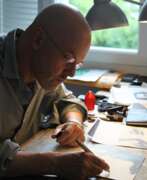

Marcel van Eeden is a Dutch draftsman and painter. From 1989 to 1993 van Eeden studied painting at the Royal Academy of Art in The Hague. Van Eeden lives and works in Zurich and The Hague. Characteristically, van Eeden's work is reminiscent of the film-noir period, of almost photo-realistic depictions and he manipulates the use of the black and white contrast. A wider audience was introduced to his work after his contribution to the Berlin Biennale in 2006.
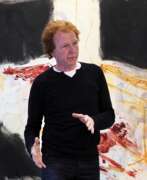

Frank van Hemert is a Dutch painter, printmaker, sculptor and drawer. His paintings, created in series, have autobiographical themes and address fundamental themes of human existence: death and sexuality. His figurative and often colorful works are expressionistic in nature.
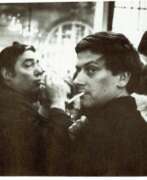

Gerard Verdijk was a Dutch abstractionist painter who worked in a wide range of materials and techniques.
Curious and eager to learn new things, he traveled to Europe, Turkey, the Middle East, North America, Africa and Japan to experience other cultures.
Verdijk's work cannot be attributed to any one historical and artistic movement. The ever-changing world around him influenced his style and use of materials.


Ernst Vijlbrief is a Dutch visual artist and board member of several artists' associations, including Beroepsvereniging van Beeldende Kunstenaars.
Ernst Vijlbrief worked in various techniques, he also created calligraphic improvisations on paper.
His painting style in the 1950s was expressionist, in line with Cobra's style. Around 1968 he made a series of figurative drawings. In 1970 he created the sculpture The Captain, an allusion to Edy de Wilde as director of the Stedelijk Museum, which was shown at Galerie Kristiaan in Amsterdam.


Carel Nicolaas Visser was a Dutch sculptor. He studied at the Royal Academy of Art in The Hague, where he was influenced by the work of artists such as Piet Mondrian and Georges Vantongerloo.
Visser's early work was characterized by his use of industrial materials such as steel and iron. He often worked with found objects, transforming them into abstract sculptures that explored the relationship between form and space.
In the 1960s, Visser's work began to incorporate more organic shapes and materials, such as wood and stone. He continued to experiment with a wide range of materials throughout his career, creating sculptures that were often characterized by their simplicity and elegance.
Visser's work has been exhibited in major museums and galleries around the world, including the Stedelijk Museum in Amsterdam, the Centre Georges Pompidou in Paris, and the Museum of Modern Art in New York. He is considered one of the most important sculptors of the post-war period, and his influence can be seen in the work of many contemporary artists working today.
